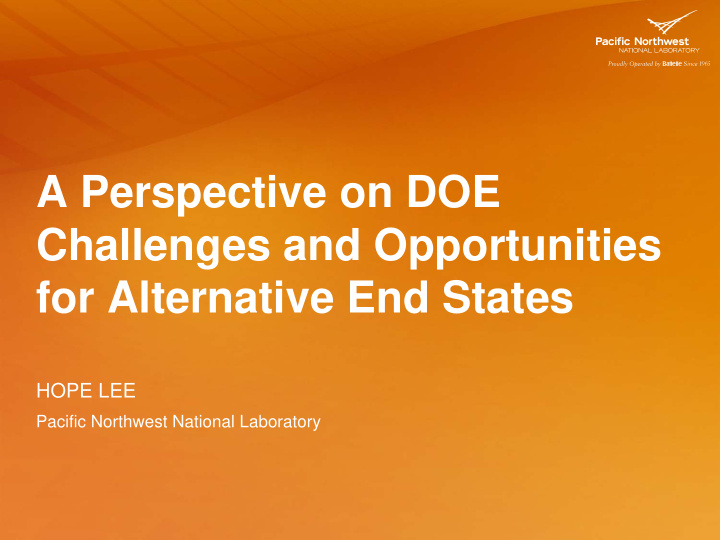



A Perspective on DOE Challenges and Opportunities for Alternative End States HOPE LEE Pacific Northwest National Laboratory
Definitions End States – final remedial goals that are permitted by regulations and are protective of human health and the environment Risk-based – decision process based on analysis of the potential of a contaminant to cause immediate and long-term harm to a receptor resulting from exposure and the likelihood of occurrence Scientifically based/ technically defensible – systematic, objective understanding of a problem based on, objective approaches and independently reproducible results that provide a sound understanding and justification for decision making. 2
Why do we NEED alternate end states? Remaining sites are complex - contaminant (radionuclides and metals location (deep, fractured rock) cost ~ 300,000 sites ~$ 200 billion 3 Source: Cleaning Up the Nation’s Waste Sites: Markets and Technology Trends, 2004 Edition, EPA 542-R-04-015
What is an acceptable End State? Tradeoffs must be carefully considered among the competing influences of cost, scientific defensibility, and the amount of acceptable uncertainty in meeting remediation decision objectives Increased Scientific and Technical Defensibility Decreased Regulatory Acceptability High risk, complexity, and Scientific and technically cost with little to no defensible with minimal risk but regulatory acceptance costly and limited regulatory acceptance e.g. Enhanced attenuation Increased Cost e.g. Pump-and-Treat High risk and complexity but Scientifically and technically less costly and regulatory defensible with minimal risk or acceptable cost and regulatory e.g. Permeable reactive acceptable e.g. Surface barrier; barriers in situ bioremediation 4 Decreased Uncertainty/Risk
What are currently ‘acceptable’ End States? • Change for final cleanup standards (MCLs, pre-contaminant conditions) Attenuation (Monitored Natural Attenuation, Enhanced Attenuation): Long-term monitoring and/or limited action (~100 years) Adaptive Site Management: Iterative approach; altered over time in response to site conditions Groundwater Reclassification: Changes state regulations so groundwater is no longer classified as drinking water Alternate Concentration Limits (ACL): Replace or modify groundwater cleanup standard at sites where contaminated groundwater discharges to surface water; risk- based value ARAR (Applicable or Relevant and Appropriate Requirements) Waivers TI waivers: Compliance with requirement is technically improbable from an engineering perspective 5
How do we get there? … Framework 6
How do we get there … risk considerations • Risk needs to be evaluated at multiple levels and integrated for a holistic view of choosing alternate end state Human Health Ecological • Balance current needs and drivers with future land use • Cognizant of dollars saved River versus risk reduction resources • Are there high-consequence hazards where risk is always too great 7
What it IS NOT and IS • Walk-away approach Long-term management including regular review of site conceptual model (SCM) to address residual contamination and employ new technologies and approaches as they are available in out years • A quick or easy fix Based on robust, holistic SCMs which provide platform for more accurate predictions and risk-informed decisions • Un-Protective of human health and environment Considers all aspects of risk- present and future, re-evaluated within context of resource-use goals or other significant changes in model assumptions • Rigid and inflexible Iterative approach providing transition of sites from active remediation or intensive characterization and monitoring into systems-based LTM strategies 8
How do we achieve these goals? • What has been done at other sites • Interagency collaboration • Lessons Learned • Technology/expertise transfer Resources available include: Assessing Alternative Endpoints for Groundwater Remediation at Contaminated Sites EPA policy and guidance ITRC overview document and training Navy Alternative Restoration Technology Team workgroup AFCEE and Army initiatives ESTCPs’ Alternative Endpoints and Approaches for Groundwater Remediation • Regulatory and stakeholder engagement • Risk-informed understanding and defensibility • Robust long-term management of residual contamination 9
DOE goals for subsurface • Reduce the life-cycle costs and accelerate the cleanup of the Cold War environmental legacy • Reduce the EM legacy footprint by 40 percent by the end of 2011, leading to approximately 90 percent reduction by 2015 10
11
Benefits • Set common expectations and acceptable terms (between agencies and contractors) for remedial performance • Meet regulatory requirements despite technical challenges & limitations • Leverage resources • Define reliable ways to manage long-term residual contamination, cognizant of human health and environment • Achieve risk-informed end states 12
Acknowledgments • Department of Energy, Environmental Management Office • Department of Energy, Richland Office • Dawn Wellman, PNNL • Mike Truex, PNNL • Resource documents: ESTCPs’ Alternative Endpoints and Approaches for Groundwater Remediation Cleaning Up the Nation’s Waste Sites: Markets and Technology Trends, EPA 542-R-04-015 13
Recommend
More recommend